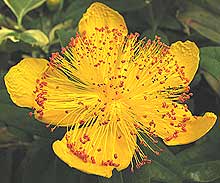
Rain Scald or 'Rain Rot' - Symptoms and how to treat a horse with homeopathic remedies and homeopathy

Hypericum can be used to treat
rain scald
Rain scald tends to occur on a horse or pony over the winter months when the weather is very wet .
Like mud fever, rain scald is a common problem in winter for horses.
It is sometimes referred to as equine dermatophilosis, a name derived from the main type of bacteria that cause rain scald on horses and ponies.
Occasionally different types of bacteria such as Staphylococci can also play a part in causing Rain Rot on a horse.
SIGNS AND SYMPTOMS OF RAIN SCALD ON A HORSE OR PONY
The signs and symptoms of rain scald on a horse or pony are easy to spot - the coat and skin look as though the skin has been scalded with droplets of water.
Thehairs of the coat are clumped together so that the tufts sometimes appear a little bit like paint brushes
This rain scaldeffect is caused by the horse's skin exuding a sticky secretion which sticks the hairs of the horse's coat together.
Eventually scabs form which are usually small, but can be up to 2cm in diameter or sometimes even bigger.
Although not itchy the scabby areas of rain scald are painful to touch.
If the scabs are removed the area underneath will be sore and may bleed a little.
CHOOSING A HOMEOPATHIC REMEDY FOR A HORSE WITH RAIN SCALD
There are several homeopathic remediesfor rain scald that are worth trying on a horse with rain scald or rain rot:
- Dulcamara 30c
- A good general homeopathic remedy for rain scald
- Graphites 30c
- The use of Graphites is indicated where the skin lesions of the rain
scald are very sticky or weeping.
- Mezerium 30c
- Mezerium benefits conditions where there are thick scabs.
- Rhus Tox 6c
- Rhus tox is of greatest benefit where the horse's skin is very inflamed.
- Hypericum
- Give hypericum, also known as St John's Wort, 1 to 3 times a day
for 3 to 4 days until the symptoms start to abate.
- Sepia
- Recommended for treating mares and fillies with rain scald
Calendula and Thuja are also often
recommended
A tincture of Calendula sprayed on the sore areas can be very effective.